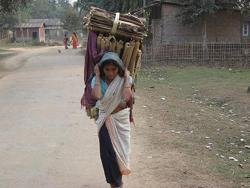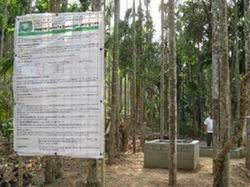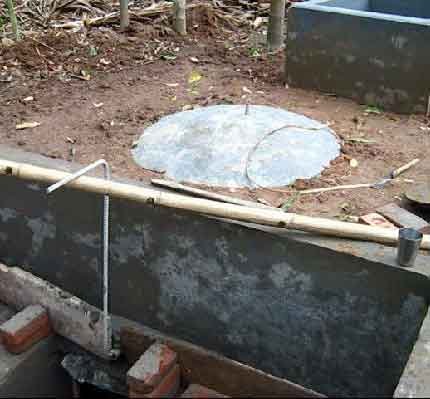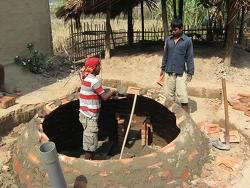Dipchang Atmasahai gut from Sonoabori village, Mirogoan dist., Assam India with twenty women member’s lead by Ms. Rupa Bordoloi, one of the largest group joined the projec
The Bio-Energy Bio-Manure mitigation challenge to Global Change
India the second largest populous country globally with potentials to outnumber China by 2050 faces a growing energy and soil fertility mitigation challenge. Resource augmentation and growth in energy supply have not been able to keep in pace with ever increasing demands and thus the country faces a demand supply gap of about 11% energy shortage and 14% peak power shortage. Efficient utilization of India’s renewable energy sources for on & off grid application through Renewable Energy Technologies (RETs) like biomass gasifiers, solar photo voltaic, micro hydro, biogas, etc. can generate a significant impact on India’s energy security.
It can be agreed to the fact that a significant role can be played by biogas plants, because of its large scale feasibility and cost effectiveness compared to other RETs and the multiple benefits the technology can offer. The biogas plant is also a viable answer to the new global outlook in converting bio-waste into a wealth of high end useable commodity in addition to meeting the growing rural & urban energy security and in addressing climate change. Using biogas energy solves the most serious problem of energy security in rural areas, where people traditionally forage for fuel wood in forest. Africa lost 64 million ha of forest between 1990 and 2005, more than any other continent, where fuel wood gathering was a major cause of forest depletion.

Fuel wood pressures at RCSD project area, a common rural energy overview NE India
The challenge in reaching out
India’s National Biogas and Manure Management Program catering to the setting up of family type biogas plants has been in operation since 1981-82 providing various incentives and support services, where about 3.93 million plants have been set up against an estimated potential of 12 million plants with an operational rate of 66%. While we achieve fresh targets, the daunting challenge lies in generating ample awareness of multiple benefits the technology offers; reviving the large number of non-functional biogas units; and in making the biogas plants accessible to the majority of poor farming households who possess the requisite bio-feed resource but lack access to technology and can less afford to generate the seed money for setting up the biogas digester
With an objective to strengthen the greater methane recovery process with project support from Centre for Microfinance & Livelihood (CML). RCSD initiated the setting up promotional demonstration units in two adjoining panchayat with the help of local SHGs as project partners, and with ample awareness raising and capacity building of the target groups. The idea of involving the SHGs is to develop proliferation of grassroot institutions into technical service providers / rural technical hubs (RTH) with adequate capacity building and hand holding on an innovative business and financing mode in the long run. The approach adopted will not only help diversify activities of the SHGs and generate employment avenues in new areas, but will also help in increasing the operational rate of rural biogas plants and thereby act as a driver to promote micro financing of rural farm and energy technologies. Resolve financial & technical barriers amongst the poorest of the poor and bring about easy access of rural technology within the village and help address village energy security and help caring for the local enviornmant. Within the ongoing process of project implementation, RCSD has developed a step wise documentary video on biogas development, which will be of help for the upcoming service providers to utilize as communication & publicity material for generating confidence amongst the rural poor to invest on the technology.

A biogas awareness poster in local dialect hoisted at a user site. A confidence building exercise for investment & proliferation
R&D for improving plant efficiencies
While a number of proven digester technologies have emerged over the last decades, answers to design specific issues remains and their lies ample potentials for improving the digester for greater efficiency, ease of maintenance and durability. RCSD chose to adopt the family size deenbandhu model for implementation in Polasong and Belguri village, in Kamrup district of Assam amongst very poor Schedule Tribe (ST) households and is working out strategies in resolving scum formation issues and in increasing the efficiency of the biogas digester under the present traditional custom of stall feeding restricting to only night hours in Assam, India. In order to resolve the issue of scum formation in a cost effective manner, researchers at RCSD, together with the master technician Mr. Nurjamal Sk designed a low cost stirrer made of 20 mm iron bar fitted with 1” iron plates for slow half moon operation for trial. Another approach to increase the effectiveness of gas production in the biogas digester has been through the introduction of separation walls in the digester for effective regulation of the bio-feed mixture. The experiments under trial are being monitored with the help of the users and can lead to viable solutions in improved management of small and medium sized biogas digesters and in enhance CH4 gas recovery.

Experimental efficiency trials of biogas digester at RCSD site
Microfinance
Most of the RET inclusive of biogas, are generally found within the premises of affluent homes and in accessible rural areas, however to make RETs (e,g. biogas) affordable and within the reach of the poorest of the poor in rural India calls for innovative approaches supported by microfinance mechanism. It’s a true fact that most of the village communities located in remote location are generally poor and possess subsistence income to pay the additional cost involved in installation of the biogas plant beyond the subsidies as the system cost increase with increased transportation cost of material goods to such sites. Thus there arises the need for affordable means of credit supported by Micro Finance Institutions (MFIs) in strategic location. Participation of Centre for Microfinance & Livelihood (CML) in the project is envisage to convince other MFIs that on-farm technology (e.g. biogas-bio manure) are mature and appropriate, whereby MFIs are convinced that their clients can pay for systems either from increased farm income or from household savings generated as a result of installation of systems. Partnership with CML can therefore be a pathfinder for MFIs to help promote a spurt of microfinance activities towards RETs to meet the rural energy, bio-manure and cash needs in small and marginal rural farms in the long run
Biogas and Global Carbon Market
Fermentation of organic waste (e.g. dung, kitchen waste) in a biogas digester and subsequent application of the biogas and the bio-manure contributes to Global reduction of Green house gases (GHG) and qualifies for Clean Development Mechanism (CDM) of UNFCCC7. The technology takes a proactive role in sinking greenhouse effect by reducing the burning of conventional fossil fuels & woody biomass in meeting large scale domestic energy requirements. Bio-slurry produced leads to reduction in the use of artificially produced mineral fertilizers in farms thereby reduce atmospheric CO2 by increased carbon sequestration i.e. increased retention of CO2 in the soil. By reducing fuel wood burdens in community and natural forest, it can assist in restoration of ecosystem services and sustains the capability of forests to act as a carbon sink, in addition to drudgery reduction, particularly amongst women folks from endless fuel wood collection and transport.

A 2m3 biogas plant under construction at RCSD , CML project site, with capacity to replace, 26 kg of LPG / 37 litres of kerosene / 88 kg of charcoal / 210 kg of fuelwood / 740 kg of animal dung cake per month.




Comments (0)